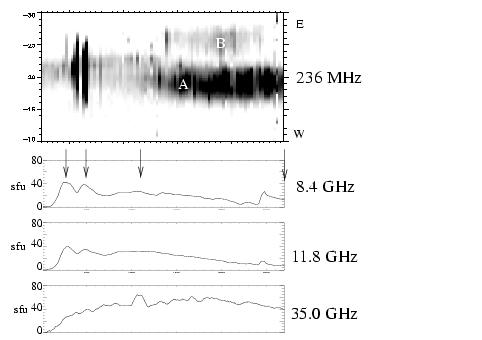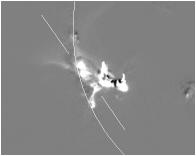
Normally we write these Yohkoh science nuggets mostly about coronal soft X-ray sources. We call such sources thermal when the energy distribution in their plasmas can be characterized with a single quantity, their temperature. However to a radio astronomer, particularly one who works at long wavelengths where one can see high up in the corona, the main thrills are in processes that distribute energies in ways that are not thermal at all. The various phenomena reflect the presence of non-thermal and even relativistic particles, like the ones in the radiation belts (Van Allen Belts) around the Earth. High-energy solar events emit hard X-rays, gamma-rays, and copious "solar cosmic rays" (a bit of an oxymoron but it gives you the idea). Of course they are related to flares and coronal mass ejections, but the phenomena are quite distinctive.
As mentioned above, the radio astronomers who look at long wavelengths have good views of non-thermal particles. But technology is improving, and now it's possible to get signatures at the shortest rado wavelengths. ISAS and Nobeyama visitor Silja Pohjolainen brought to our attention the event described here - it was detected at millimeter-wave sites in Finland at Tuorla Observatory and in Switzerland at KOSMA observatory. The time series of data below show why it's interesting:

The high-frequency (35 GHz) trace at the bottom of the chart shows a slow event with a large (for mm-waves) flux. It's measured in sfu, or solar flux units -- reaching 60 sfu, and lasting for tens of minutes (sorry to say the time axis got cut off the plot). The two traces above it (11.8 and 8.4 GHZ) show microwaves (few-cm wavelengths), which reflect the mm-wave source but also show an impulsive burst at the time marked by the first arrow. Finally, at the top, we have one-dimensional images formed by the Nancay radioheliograph at 236 MHz, which corresponds to meter wavelengths. The images are an EW projection, so that the top of the figure (source B) corresponds to a position above the limb. It also suggests the mm-wave time profile.
The reasons are a bit technical, but the data simply do not fit a thermal explanation (see the radio spectrum for the evidence of a nonthermal spectrum with very high flux at high frequencies). We have precious little literature on this kind of source, but enough to know that the new HESSI observations will be very interesting. HESSI, to be launched in March 2001, will take the next step in sensitive hard X-ray and gamma-ray observations of coronal sources. Meanwhile, thanks to Silja Pohjolainen for bringing this event around, which encourages us to continue our efforts to find related things in Yohkoh data.
Obviously we want to identify such a source with soft X-rays, which have shown us beautiful images of many types of long-wavelength coronal radio source. But it is not obvious what to identify the mm-wave source with! Here are several views of a difference image:

Several views are necessary, because of the dynamic range of the observations. In the rightmost view one can see a faint cusp structure extending up above the solar limb; locate the limb from the image below, which also marks the axis of the (faint) arcade below the cusp structure:

What we think is happening is that a large number of relativistic electrons have somehow found themselves accelerated and stably trapped in closed magnetic structures in the corona. Such a conjecture opens a lot of questions, and really there's no alternative but to answer them - it must be true. The few events of this "purely coronal" type (see Hudson, ApJ 224, 235, 1978) in the past (the most famous being March 30, 1969, and May 13, 1981 perhaps) were reviewed and discussed in a paper by E. Cliver (see ApJ 305, 920, 1986 for the nitty-gritty). But how could such a trivial flare result in such a wholesale particle acceleration? Is it rare, or common and just hard to see happening? Is it for similar reasons that a trivial flare can accompany a humongous coronal mass ejection? Truly, the solar corona contains mysteries that are still beyond our powers. We need more mm-wave and hard X-ray observations for sure!
February 9, 2001